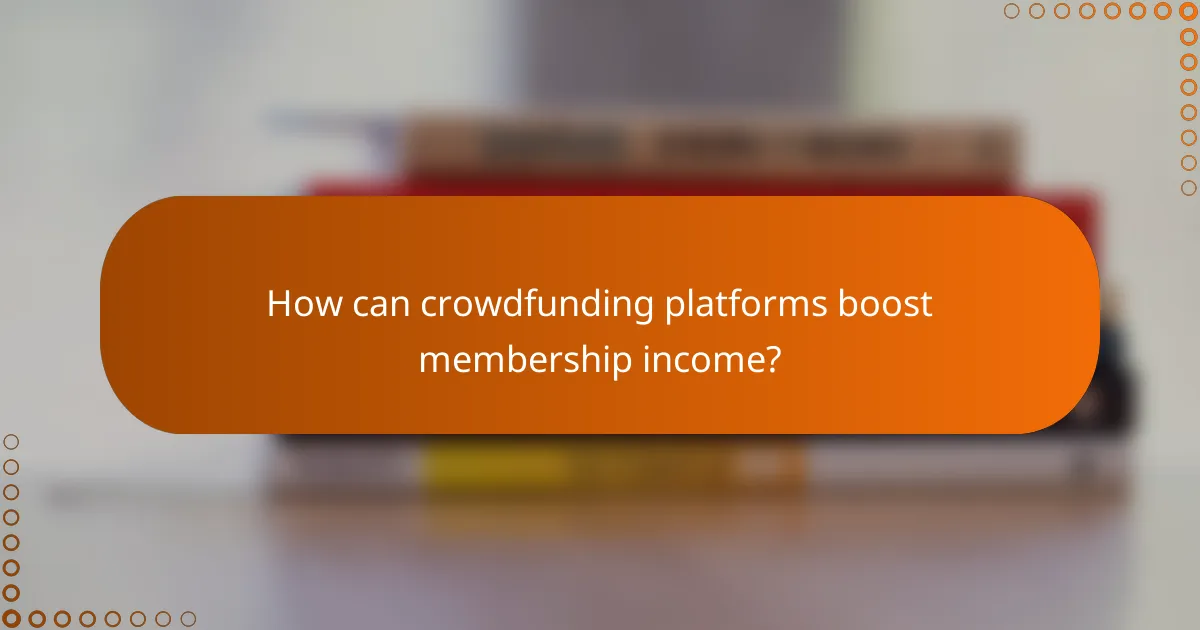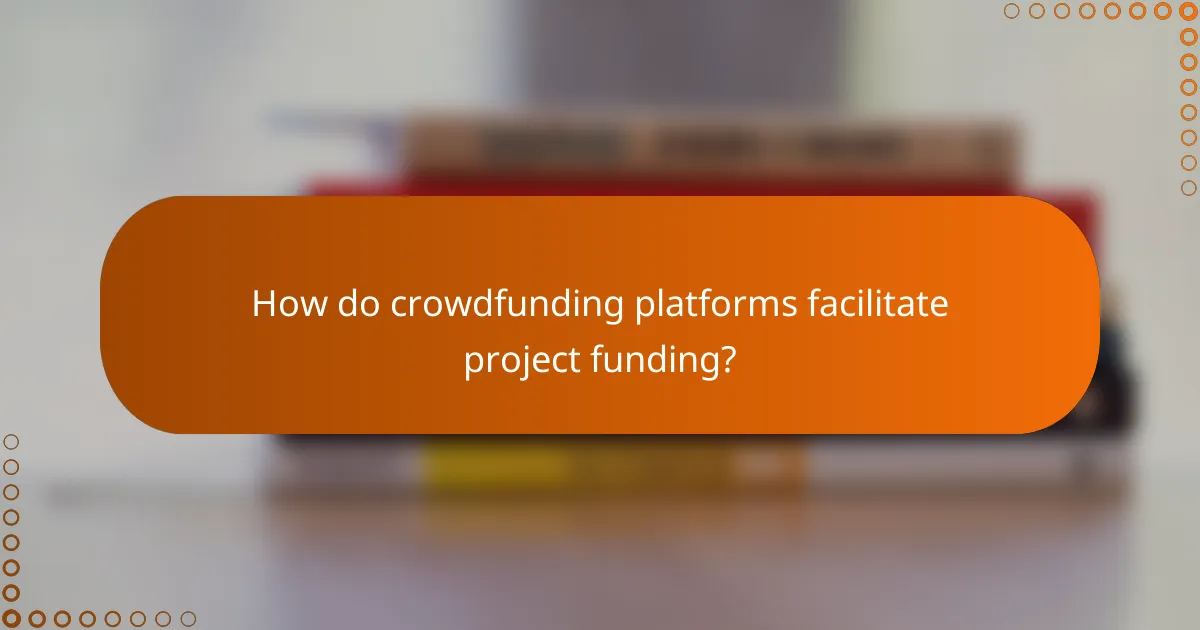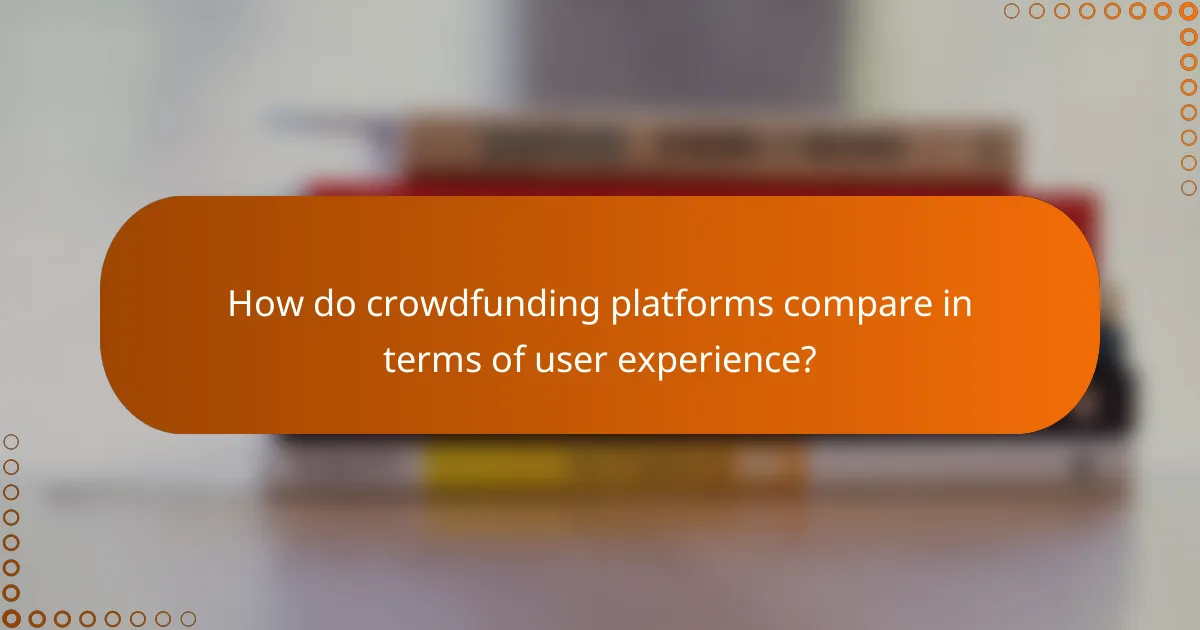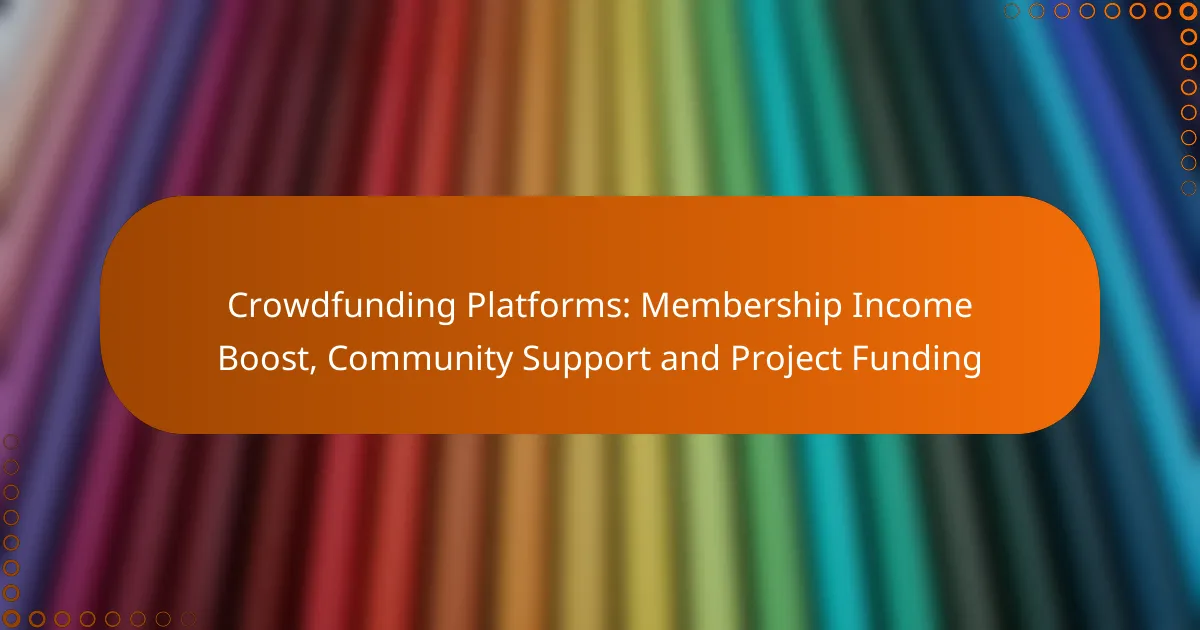Crowdfunding platforms play a vital role in boosting membership income by facilitating structured financial support from communities. They not only create opportunities for recurring revenue through tiered benefits but also foster strong relationships between creators and backers, enhancing community engagement. Additionally, these platforms connect project creators with potential supporters, enabling them to raise necessary funds while cultivating a loyal community around their ideas.

How can crowdfunding platforms boost membership income?
Crowdfunding platforms can significantly enhance membership income by providing a structured way to gather financial support from a community. They enable organizations to create recurring revenue streams, offer tiered benefits, and engage members through exclusive content and community initiatives.
Recurring revenue models
Recurring revenue models are essential for sustaining membership income. By setting up monthly or annual subscription options, organizations can create predictable cash flow. This approach not only stabilizes finances but also encourages long-term member commitment.
Consider implementing automatic billing for memberships, which can reduce churn rates. Offering incentives for annual payments, such as discounts, can further enhance this model.
Tiered membership benefits
Tiered membership benefits allow organizations to cater to different levels of financial support. By offering various membership levels, such as basic, premium, and elite, you can attract a wider audience and encourage upgrades. Each tier can provide distinct benefits, such as exclusive events or merchandise.
For example, a basic membership might offer access to a newsletter, while a premium tier could include invitations to special events and exclusive content. This strategy can motivate members to contribute more for enhanced experiences.
Exclusive content access
Providing exclusive content is a powerful way to boost membership income. Members are often willing to pay for unique resources, such as webinars, tutorials, or behind-the-scenes insights that are not available to the general public. This creates a sense of value and belonging within the community.
Consider creating a members-only section on your website where this content can be easily accessed. Regular updates and new offerings can keep members engaged and encourage ongoing subscriptions.
Community engagement strategies
Effective community engagement strategies can significantly enhance membership income by fostering a sense of belonging. Organizing events, both online and offline, can strengthen relationships among members and encourage participation. This could include Q&A sessions, workshops, or social gatherings.
Utilizing social media platforms to create discussions and share success stories can also enhance community ties. Encourage members to share their experiences and feedback, making them feel valued and more likely to maintain their membership.

What are the best crowdfunding platforms for community support?
The best crowdfunding platforms for community support focus on building strong relationships between creators and their backers. These platforms enable individuals and organizations to gather financial backing while fostering a sense of community engagement and loyalty.
Patreon for creators
Patreon is designed specifically for creators who want to earn recurring income from their supporters. By offering subscription-based memberships, creators can provide exclusive content, rewards, or experiences to their patrons, ensuring a steady stream of income.
To succeed on Patreon, creators should clearly communicate the value of their offerings and set realistic membership tiers. Engaging with patrons through updates and personalized content can significantly enhance community support and retention.
Kickstarter for project funding
Kickstarter is a popular platform for funding creative projects, from art installations to innovative products. It operates on an all-or-nothing model, meaning projects must reach their funding goal to receive any money pledged.
To effectively use Kickstarter, project creators should develop a compelling pitch, including a clear description, engaging visuals, and a well-defined budget. Offering attractive rewards for backers can incentivize contributions, while maintaining transparency about project progress fosters trust within the community.
Indiegogo for flexible funding
Indiegogo provides a flexible funding option that allows creators to keep funds even if they do not meet their initial goal. This feature can be particularly beneficial for projects that require ongoing support or have variable funding needs.
When using Indiegogo, creators should focus on crafting a strong campaign narrative and utilizing promotional tools available on the platform. Engaging with backers through updates and feedback can help build a loyal community and encourage further support for future projects.

How do crowdfunding platforms facilitate project funding?
Crowdfunding platforms enable project funding by connecting creators with potential backers who contribute small amounts of money. This collective effort allows individuals and businesses to raise the necessary capital for their projects while building a community around their ideas.
Funding goal setting
Setting a clear funding goal is crucial for a successful crowdfunding campaign. This goal should reflect the minimum amount needed to launch the project effectively, typically ranging from a few thousand to several hundred thousand dollars, depending on the project’s scope.
Consider breaking down the goal into specific milestones to encourage backers to contribute at different levels. For example, if your goal is $50,000, you might set milestones at $10,000 increments to create a sense of progress and urgency.
Reward structures for backers
Offering attractive rewards is essential for motivating backers to support your project. Common reward structures include tiered incentives, where backers receive different rewards based on their contribution level, ranging from small tokens for low contributions to exclusive experiences or products for higher amounts.
Ensure that the rewards are relevant and appealing to your target audience. For instance, if you’re funding a creative project, consider offering limited edition merchandise or behind-the-scenes access as incentives.
Marketing strategies for campaigns
Effective marketing is vital for driving traffic to your crowdfunding campaign. Utilize social media platforms, email newsletters, and online communities to spread the word about your project. Engaging storytelling can help connect with potential backers emotionally.
Consider leveraging partnerships with influencers or relevant organizations to expand your reach. Additionally, creating a compelling video that outlines your project can significantly enhance your campaign’s visibility and attractiveness.

What criteria should you consider when choosing a crowdfunding platform?
When selecting a crowdfunding platform, consider factors such as fee structures, audience reach, and project success rates. These elements can significantly impact your project’s financial viability and overall success.
Fee structures and costs
Different crowdfunding platforms have varying fee structures, which can include flat fees, percentage-based fees, or a combination of both. Typically, platforms charge between 5% to 10% of the total funds raised, but some may have additional costs for payment processing or promotional features.
Before committing, review the total costs associated with each platform, including any hidden fees. This will help you determine which option aligns best with your budget and funding goals.
Platform reach and audience
The reach and audience of a crowdfunding platform can greatly influence your project’s visibility and funding potential. Some platforms cater to niche markets, while others have a broader audience, which may be beneficial for general projects.
Research the demographics of each platform’s user base to ensure it aligns with your target audience. For example, platforms focused on creative projects may attract different backers than those aimed at tech innovations.
Success rates of projects
Success rates can vary widely among crowdfunding platforms, with some reporting success rates of around 30% to 50% for projects. Understanding these rates can help you gauge the likelihood of your project’s success on a given platform.
Look for platforms that provide transparency regarding their success statistics. This information can guide your decision and help you set realistic funding goals based on historical performance.

How do crowdfunding platforms compare in terms of user experience?
Crowdfunding platforms vary significantly in user experience, impacting how easily users can navigate, seek support, and promote their projects. Key factors include interface design, customer support options, and social media integration, all of which play a crucial role in the overall user satisfaction and project success.
Interface design and usability
The interface design of a crowdfunding platform greatly influences usability. A clean, intuitive layout allows users to quickly find essential features, such as project creation tools and funding options. Platforms like Kickstarter and Indiegogo are known for their user-friendly interfaces, which typically require minimal clicks to navigate.
When evaluating usability, consider the learning curve. Some platforms may offer advanced features that can be overwhelming for new users. Opt for platforms that provide guided tutorials or help sections to ease the onboarding process.
Customer support options
Customer support is vital for resolving issues that may arise during a crowdfunding campaign. Many platforms offer various support channels, including email, live chat, and phone support. For instance, GoFundMe is recognized for its responsive customer service, which can be crucial during critical campaign periods.
It’s important to check the availability of support options, especially if you anticipate needing assistance. Platforms that offer 24/7 support may provide peace of mind, while those with limited hours could lead to delays in resolving urgent issues.
Integration with social media
Effective social media integration can significantly enhance a crowdfunding campaign’s reach and visibility. Platforms that allow easy sharing on popular networks like Facebook, Twitter, and Instagram enable users to promote their projects to a broader audience. This feature is essential for driving traffic and attracting potential backers.
When selecting a platform, look for those that provide built-in sharing tools or analytics to track social media engagement. This can help you understand which channels are most effective for your campaign, allowing you to focus your promotional efforts accordingly.

What are the emerging trends in crowdfunding platforms?
Emerging trends in crowdfunding platforms include decentralized models and impact investing, which are reshaping how projects are funded and supported. These trends reflect a growing desire for community involvement and social responsibility in funding initiatives.
Decentralized crowdfunding models
Decentralized crowdfunding models leverage blockchain technology to create platforms that operate without a central authority. This approach enhances transparency and reduces fees, allowing creators to retain more of their funds. Examples include platforms like Gitcoin and Kickstarter’s blockchain initiatives.
When considering decentralized crowdfunding, assess the platform’s user base and the types of projects it supports. While these models can offer greater freedom, they may also come with regulatory uncertainties and varying levels of community engagement.
Impact investing through crowdfunding
Impact investing through crowdfunding focuses on funding projects that generate social or environmental benefits alongside financial returns. This trend attracts investors who prioritize ethical considerations, such as renewable energy initiatives or social enterprises. Platforms like Seedrs and Indiegogo have started to feature impact-driven projects prominently.
To engage in impact investing, evaluate the project’s mission and its potential for measurable outcomes. Investors should be aware of the risks involved, as these projects may not always yield high financial returns compared to traditional investments. Consider diversifying your portfolio with a mix of impact and conventional investments to balance risk and purpose.
